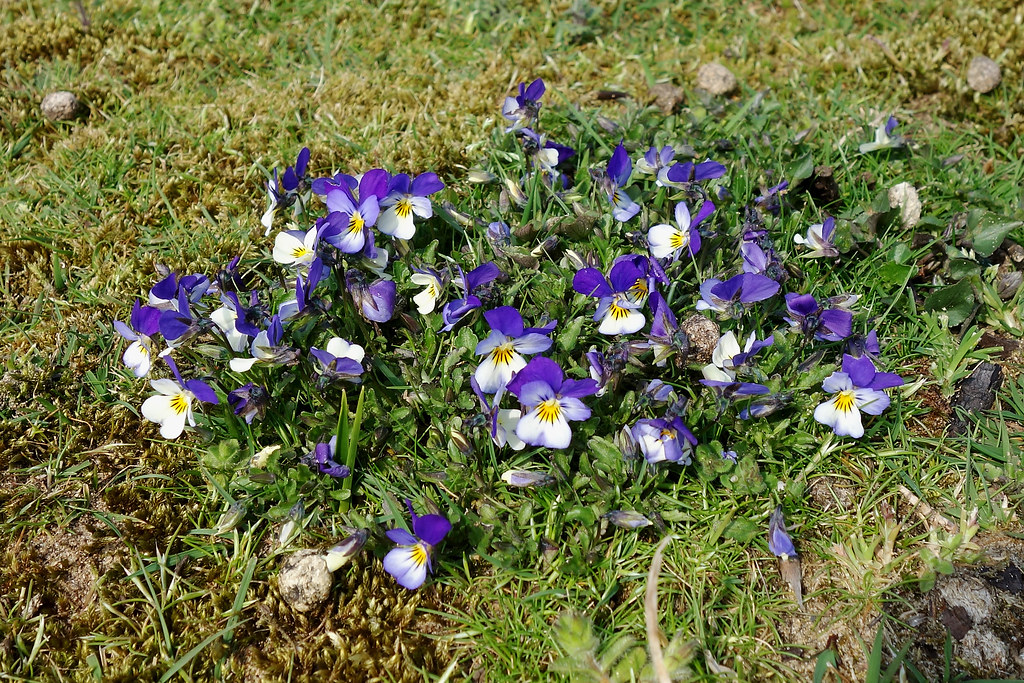It is a journey packed with unexpected discoveries, some being more welcome than the others. Envision this: You have just moved into your dream abode, and the excitement is distinctly perceptible. While you look out onto your novel lawn, amidst the greenery, you notice a vast sea of purple. Intrigued and slightly perplexed, you find yourself pondering the identity of these resilient floral warriors that have claimed your yard as their battleground. Fear not, for we’re about to embark on an exploratory mission, diving deep into the world of common lawn weeds with purple flowers, unearthing their secrets, and arming you with the knowledge to reclaim your green kingdom.
Identifying Purple-Flowered Lawn Weeds

Our tale begins as we introduce the contenders, each with its unique charm and conquest strategy. First, meet the Purple Deadnettle (Lamium purpureum) and its close relative, Henbit (Lamium amplexicaule), members of the mint family that grace our lawns with their vibrant purple flowers. These two botanical buccaneers emerge as the cold season wanes, setting the stage for their springtime siege. Purple Deadnettle, with its heart-shaped leaves tinged with purple, and Henbit, showcasing leaves that clasp the stem, both share a penchant for fertile, well-drained soils, making your lawn an ideal territory for their expansion.

But our floral invaders do not stop there. Enter Ground Ivy, also known as Creeping Charlie (Glechoma hederacea), with its bluish-purple tubular flowers and prostrate growth habit, forming dense mats that blanket the ground. This perennial weed’s adaptability to shade and moisture makes it a formidable foe, capable of outcompeting grass and establishing a creeping dominion over your lawn.

And who could overlook the enchanting Creeping Bellflower (Campanula rapunculoides)? Its bell-shaped flowers may captivate the eye, but don’t be fooled by its beauty. This invasive perennial, spreading through rhizomes, can quickly transform from a garden delight to a gardener’s nightmare, challenging even the most seasoned lawn care enthusiast.

Our narrative would be incomplete without mentioning the thistle brigade – Musk (Carduus nutans), Canada (Cirsium arvense), and Bull Thistle (Cirsium vulgare). These spiky adversaries, with their purple crowns, stand tall, declaring their presence and readiness to conquer. Their resilience and rapid spread through seeds make them a tough nut to crack, demanding prompt attention and action.

In the realms of the less known, we encounter Wild Pansies or Violets (Viola tricolor), with their heart-shaped leaves and distinctive ‘face’ pattern flowers, and Purple Cudweed (Gnaphalium purpureum), a low-growing annual that forms a ground-level rosette. While they may not boast the aggressive nature of their counterparts, their ability to spread and compete for resources poses a significant challenge to maintaining a pristine lawn.
What binds these diverse characters together, aside from their captivating hues? It’s their insatiable appetite for sunlight, water, and nutrients – the very essence of what makes a lawn thrive. Left unchecked, they can smother grass entirely, transforming your lush green into a canvas of purple. But fear not, for knowledge is power. Understanding the nature of these invaders is the first step toward crafting a robust defense, ensuring that your lawn remains a verdant haven, a place of beauty and tranquility amidst the chaos of nature’s whims.
As we delve deeper into the world of these purple-flowered lawn weeds, we unravel the complexities of their growth habits, habitats, and life cycles. From the low-growing Purple Deadnettle to the towering thistles, each has carved its niche, exploiting the vulnerabilities of our carefully tended lawns. Their resilience through frosty Aprils and their ability to muscle through like champs are testaments to their tenacity. But as homeowners, armed with a deeper understanding and appreciation for the challenges these weeds present, we stand ready to embark on a strategic battle to reclaim our outdoor spaces. Stay tuned as we shift our focus to the arsenal at our disposal in our ongoing saga of lawn care and weed management.
How To Do Lawn Care For Weed Control
Welcome back, valiant homeowners, to the second chapter of our lawn liberation saga! As we venture further into the battleground of our green spaces, it’s clear that a more tactical approach is needed to fend off the purple-flowered usurpers. So, strap on your garden gloves and gather your tools, as we dive into the strategic weed warfare required to maintain a pristine lawn.
In any battle, knowledge of the enemy is key, and our purple invaders are no exception. Identifying the specific type of weed you’re dealing with is the first step in crafting an effective counter-strategy. Remember, each species has its unique growth habits and vulnerabilities. Purple deadnettle and henbit, for instance, are winter warriors that prelude the spring with their floral display. These early bloomers are often caught off guard by a well-timed pre-emergent herbicide in the fall.
The ground ivy, also known as creeping Charlie, with its relentless creeping nature, requires a different approach. This adversary thrives in the shade and moist conditions, making it essential to reduce shade and improve drainage wherever possible. For this tenacious foe, selective post-emergent herbicides might just be the silver bullet, especially when applied in the fall, as the weed stores energy for winter.
Creeping bellflower, with its deceptive beauty, is another formidable opponent. Its extensive rhizome system calls for persistent efforts, combining manual removal with selective herbicide applications. The goal here is to exhaust the weed’s resources, making it crucial to attack not just the visible parts but also its underground network.
The thistle brigade, with their spiky armor, presents a piercing challenge. Manual efforts can be effective for small infestations, but for larger battles, a combination of pre and post-emergent herbicides tailored to your lawn type can provide a much-needed edge.
Let’s not forget about our less aggressive but equally stubborn enemies: wild pansies, purple cudweed, and others. These opportunists exploit any weakness in your lawn’s health, making it essential to maintain a robust lawn care regimen. Proper mowing, watering, and fertilization are not just good practice; they’re your lawn’s best defense against invasion.
In addition to these cultural practices, mulching plays a crucial role in preventing weed seeds from finding a foothold. A well-mulched garden bed can be an impenetrable fortress, denying weeds the very ground they seek to conquer.
For those seeking a more targeted approach, selective herbicides offer a precision strike capability. These chemical allies are designed to target specific weeds while sparing your grass, making them invaluable tools in your arsenal. However, the proper application is key; timing and adherence to label instructions can make the difference between victory and defeat.
But what if the battlefield conditions are not in your favor? For example, in areas where desirable grass struggles to grow, consider alternatives that might fare better. Ground cover plants, for example, can provide an attractive and competitive alternative to traditional lawns, depriving weeds of both territory and resources.
As we wrap up our strategic overview, it’s important to remember that weed control is a marathon, not a sprint. Patience, persistence, and adaptation to evolving battle conditions are essential qualities for any lawn care enthusiast. With the right strategies, a keen eye for the enemy, and a bit of elbow grease, your lawn can emerge victorious, a lush green oasis in the midst of nature’s chaos.
There you have obtained it, fellow homeowners, a comprehensive guide to regaining your lawn from the clutches of purple-flowered weeds. Remember, while the battle may be daunting, the rewards—a healthy, vibrant lawn—are well worth the effort. May your lawns flourish, and your gardens remain a testament to your dedication and care. Here’s to green spaces that bring joy, beauty, and a sense of peace to our homes and lives!
Related posts:
Which Lawn Weeds Have Purple Flowers?
Weeds With Flowers: 41 Flowering Weeds With Pictures
Identifying Weeds in the Garden





